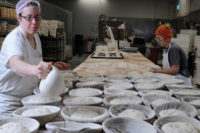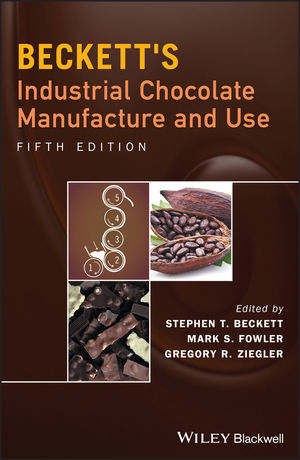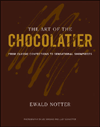Meijer’s Masterful Candy Merchandising
By Mary Ellen Kuhn
Confectioner’s Retailer of the Year nod goes to this one-stop-shopping powerhouse with an enviable ability to serve up consumer-focused retailing solutions.
Few would argue that the best retailers are the ones that recognize this essential truth: It’s about the consumer.
That’s the way it is for Confectioner’s 2007
Retailer of the Year, Grand Rapids, Mich.-based Meijer Inc. — which,
of course, has a lot to do with why Meijer clinched our annual award.
The team that leads this chain of 179 supercenter
stores spanning five Midwestern states excels at figuring out what matters
most to consumers and serving it up to them. That’s why as gasoline
prices headed to distressingly high levels this summer, Meijer gasoline
purchasers reaped the benefit of pump prices five to seven percent lower
than most competitors. The chain has experimented with text messaging loyal
consumers to alert them when a gasoline price increase is imminent.
There’s also a fuel rewards program that offers shoppers discounts at
the pump based on specific product purchases. Last year the chain even
began offering Meijer patrons some of the most commonly prescribed
antibiotics at absolutely no charge.
“It all goes back to listening to the customer,
identifying how they shop and meeting their needs,” says Bruce Efird,
executive vice president of merchandising.
“One of our primary goals is to listen to our
customers and react to the feedback as quickly as possible,” seconds
candy category buyer/merchandiser Teresa Gunst-Spicer.
Clearly the approach is working. Ray Jones, managing
partner of Northbrook, Ill.-based consulting firm Dechert-Hampe & Co.
and an architect of the National Confectioners Association’s
“best practices” candy merchandising research, has these words
of praise for the chain.
“Meijer is really dedicated to merchandising to
the consumer and doing it in a way that makes sense,” says Jones.
“They’re more of a merchant than most retailers, particularly
other big box retailers.”
Retailer of the Year scorecard
It’s not hard to come up with a list of
additional factors that played into the decision to recognize Meijer. Other
attributes for which Meijer was cited by candy manufacturers and industry
watchers include:
A commitment to candy as evidenced by a broad
assortment and ample secondary candy placements with display shippers,
endcaps and clip strips located throughout its supercenters.
Consistently
creative, solution-oriented merchandising tactics.
Solid vendor relations; Meijer enjoys an
enviable reputation for treating vendors with respect and creatively
partnering with them.
Strong seasonal candy presentations.
A well-conceived, well-executed focus on
front-end candy and gum merchandising that isn’t limited to the top
10 or 15 brands.
All in all, it’s no wonder that the
confectionery category is a strong performer for Meijer. The retailer
treats candy with the respect it deserves, recognizing its potential to
grow sales.
“We see candy as one of the ultimate,
expandable consumable categories, in that the more you buy, the more
it’s consumed,” says Efird.
Sweet solutions
Of all of the ways in which Meijer excels, perhaps the
most noteworthy is its focus on solution-oriented merchandising. What this
translates to is figuring out ways to help consumers addresses their
shopping needs.
The chain’s presentation of gift box chocolates
in the greeting card/party goods aisle is a perfect example. “This
provides our customers a gift-giving solution while shopping greeting
cards,” says Gunst-Spicer.
The selection is broad and includes brands such as
Ferrero Rocher, Hershey’s Pot of Gold, Lindt, Jelly Belly, Brown
& Haley and Zachary. A Meijer store Confectioner visited featured a handsome, wood-grain end-aisle
fixture showcasing Russell Stover and Whitman’s boxed chocolates.
This sort of approach is precisely the kind of
merchandising tactic that NCA’s best practices research recommends,
says Jones, adding that Meijer was an early adopter of the approach.
Awesome assortments
The confections assortment in Meijer stores is
expansive, as befits a supercenter retailer. Candy planograms are generated
at corporate headquarters, but requests for regional favorites can be
incorporated into the sets where it’s appropriate.
The customer base among supercenter retailers tends to
skew toward younger, larger families, and Meijer merchandisers have created
a novelty/kids candy set with lots of appeal to both kids and parents.
There’s plenty of product and price point variety. One of Confectioner’s suburban
Chicago store visits showed offerings with price points of 25 cents, 62
cents, 69 cents, $1.89 and $2.29, among others. The price structure also
encouraged multiple purchases, with offers such as 3/$4 and 4/$5.
“They do a very, very good job with
children’s products,” says consultant Jones. Stores also
feature a large assortment of bulk snacks and candy, both wrapped and
unwrapped.
A strong mainstream shopper focus hasn’t
prevented Meijer from staying contemporary with its assortment. The chain
is expanding its presence across the board in organic products, and that
has included candy.
In general, Efird reports, “We are seeing an
interest from our customers in the better-for-you products, and we’re
doing everything we can to ensure that we have the right mix.” He
adds that both dark chocolate and sugar-free products are growing segments
within the category.
Gunst-Spicer reports that the chain has expanded its
assortment of premium bars and pouches in response to increasing consumer
interest in more upscale confections.
Meijer takes full advantage of the opportunity to make
a strong candy and gum pitch to shoppers as they move toward the checkout.
“We focus a lot of time and energy on the front-end,” says
Efird modestly.
“Our current front-end fixture was introduced a
couple of years ago,” Gunst-Spicer states. “From a
confection’s standpoint, this new configuration allows us to better
merchandise gum/mints and expand our offerings to include both standard
bars and king-size bars.
“We also merchandise nostalgic candy on our
front-ends, which includes a variety of old-time candy favorites,”
she adds.
But Meijer’s front-end focus doesn’t stop
there. Distinctively shaped “arrowhead” merchandising fixtures
that face the store at the start of the checkout lane provide the retailer
with an opportunity to target shoppers right before it’s time to
begin unloading the grocery cart.
“Our arrowhead displays currently offer theater
box candy on one side, premium chocolate bars on the other side and
gum/mint items at the tip of the arrowhead,” says Gunst-Spicer.
Meijer’s front-ends are exceptionally well
managed, observes Jones. He adds that the chain includes some kids’
candy at the checkout, which is something that many retailers neglect.
Tackling the seasons
The Michigan-based mega-retailer also gets kudos for
its commitment to seasonal candy sales. “They do a wonderful job with
seasonal merchandising,” says Jones. “When you go into a
Meijer store at Christmas time,” for example, “it’s
really Christmas-y.”
“We really get behind our seasonal candy
offerings,” concurs Janet Emerson, Meijer’s executive vice
president of operations. “Seasonal candy gets high
visibility.”
It’s displayed in the center aisle of the
supercenter grocery section, and “typically receives a robust level
of space,” says Gunst-Spicer. In addition, she continues, “We
also have a seasonal aisle in many of our remodeled stores. This area acts
as a secondary location for seasonal candy during our key seasons and
provides our stores the ability to offer a broader variety to our
customers.”
And Meijer doesn’t limit its occasion-based
candy marketing to a “big four” candy holiday focus. For
Mother’s Day this past year, Meijer cross-merchandised confectionery
items in the jewelry department. Candy and snacks also are included among
other products with strong kid appeal that are featured in a summertime
“kids’ week” special event.
These sorts of themed events really help set Meijer
apart from many other big box retailers, Jones notes.
The Meijer organization is conscientious about the
fact that candy needs some close attention from an operational perspective.
“It is a very high-turning product,” says
Emerson. “We really recognize that at store level, we need to work to
ensure that the department stays full and well-presented and in-stock. The
process includes conducting detailed post-season analyses to maintain an
optimal flow of product into the stores during seasonal periods.
Vendor Relations
Meijer also racks up points in the area of vendor
relations, and, in fact, was nominated for Retailer of the Year recognition
by a leading candy manufacturer.
Consultant David Biernbaum, who has worked with Meijer
buyers and marketers, praises members of the retail team for their ability
to think outside the box.
“Basically, I think Meijer is in an enviable
position because the retail chain is large enough to be important to
suppliers, customers and vendors, and yet the chain remains independent,
agile, and regional enough to be very entrepreneurial and responsive to do
the extras,” says Biernbaum, senior sales/marketing consultant, David
Biernbaum Associates, St. Louis. “As a supplier-vendor and consultant
it is relatively easy for me to work with Meijer’s marketing
department and procurement people to make special events happen that are
very productive for Meijer, the branded suppliers, and its loyal
customers.”
What’s ahead
Meijer has been busy of late unveiling new prototype
stores and remodeling existing ones. The new format does even more to
foster consumer convenience with logical department locations and
adjacencies that make the shopping process easier. Jewelry, greeting cards
and floral, for example, have been moved up close to the front end to
address consumers’ need for one-stop gift shopping.
The Michigan-based retailer has identified suburban
Chicago as a key target market for new stores. There are currently nine
stores in the Chicago area, including one that made its debut in the suburb
of Oswego earlier this summer.
With the long-established Albertsons-owned Jewel and
Safeway’s Dominick’s dominating the market, Chicago is a tough
area for a grocery retailer to crack. Consultant Biernbaum forecasts a
continued successful expansion in metro Chicago, however, “because
they tend to be situating themselves in younger suburban neighborhoods.
“Also, Chicagoland is part of the same
Midwestern region, not far from the concentration in Michigan, Indiana and
Ohio,” Biernbaum adds.
Meijer’s overall expansion agenda includes a
total of five new stores this year, with seven additional stores planned
for 2008.
True to its roots
One of the things that many industry watchers —
and consumers as well — appreciate about Meijer is its strong grocery
orientation, which can be traced back to its origins. Founder Henrik Meijer
started as a grocer in 1934, and today the grocery strengths are a very
central part of Meijer’s place in the marketplace.
“They have not lost sight of the fact that the
consumer is coming into the store first and foremost for food items,”
says Jones, who likes to think of the supercenters as “groceries
plus” despite their massive footprints.
He sees that as a key advantage in the many markets
where Meijer goes head-to-head with Wal-Mart.
“They use their food items to lead the
store,” says Jones, adding that this is not the case with Wal-Mart
supercenters.
“My belief is that they [Meijer] have carved out
a place in the marketplace that is fairly unique,” Jones observes.
Meijer Fast Facts
Origins: First store
opened in Michigan in 1934
Headquarters: Grand
Rapids, Mich.
Ownership: Privately
held, owned by the Meijer Family
Annual Sales: $14
billion*
Number of Stores: 179
Size of New Stores: 210,000
square feet
States of Operation:
Michigan, Ohio, Indiana, Illinois and Kentucky
*Estimate
How Meijer Defines Value
Meijer’s frequently touted tagline —
“higher standards, lower prices” — does a good job of
communicating its positioning in the marketplace. The chain’s prices
tend to be lower than most supermarkets, but a bit higher than Wal-Mart.
It’s important to note, however, that value at Meijer is not just
about price, but also about product quality and convenient consumer
shopping solutions.
Meijer gets its price/value message out to consumers
via a “Weekly One Stop” advertising circular. In addition,
about a year ago, the company rolled out an ambitious price-cutting
initiative — its “Price Drop” program of unadvertised
specials. Price Drop features price reductions on a rotating assortment of
roughly 5,000 products. New items are added to and dropped from this
special sale assortment on a weekly basis.
To keep the program front and center in
consumers’ consciousness, price drop items are flagged at the shelf
level, with aisle signage and with floor graphics. It’s an
interesting approach, industry observers note, because it allows the
retailer to reap some of the benefits of both EDLP and high-low pricing
strategies.
A visit to a Chicago area Meijer store this summer
revealed plenty of promotional activity in the candy aisle. Price Drop
specials, for example, included such candy bargains as 5/$5 Tootsie-Roll
brand theater boxes, a six-pack of Snickers bars for $1.99 and
Nestlé Treasures Gold Bars priced at 2/$3. Candy-loving shoppers
also had the option of scooping up two Hershey laydown bags in order to get
two free.
Meijer’s marketing, advertising and
merchandising tactics aren’t limited to traditional approaches. The
chain also is aggressively focused on the digital marketing arena. The
Meijer Web site is localized by store and has the capacity to offer
visitors to the site customized promotions.






